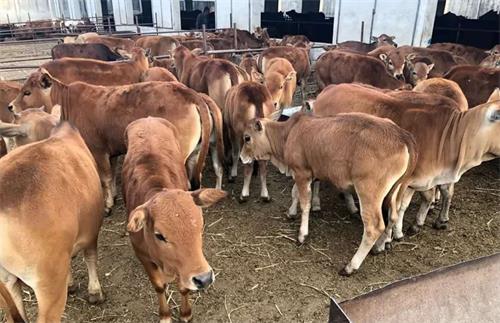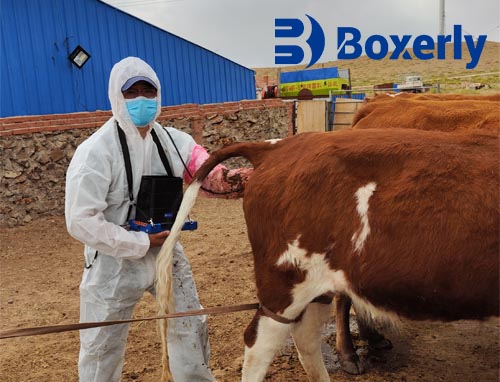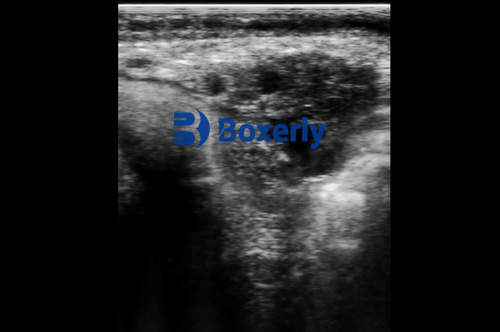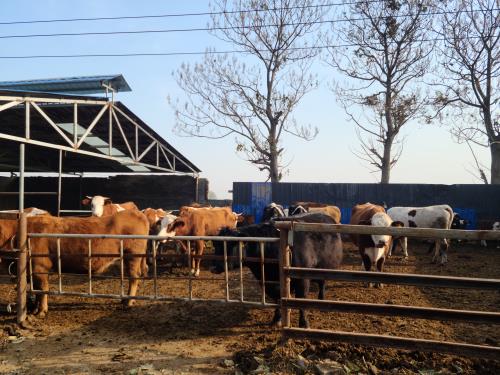In modern livestock production, accurate and early pregnancy diagnosis in cattle is critical for efficient reproductive management, economic sustainability, and animal welfare. While traditional methods like rectal palpation and hormone analysis are still widely used, ultrasonography has emerged as a superior, non-invasive diagnostic tool, offering real-time visualization of reproductive structures and fetal development. In this article, I’ll explore how ultrasound machines are used in field settings to assess pregnancy in cattle, evaluate their performance, and understand how these machines contribute to livestock sales and management decisions—based on both local practices and insights from international research and farming experience.

The Importance of Early Pregnancy Diagnosis in Cattle
Early pregnancy detection is a cornerstone of successful cattle reproduction programs. Knowing whether a cow is pregnant allows farmers to:
Optimize breeding schedules
Avoid feeding non-productive animals
Improve calving intervals
Make timely decisions regarding sale or culling
Globally, producers face similar challenges in detecting open (non-pregnant) cows early enough to rebreed them efficiently. According to research by the University of Wisconsin, delayed pregnancy detection can cost beef and dairy operations hundreds of dollars per open cow per cycle. Consequently, many farms—especially in North America, Australia, and parts of Europe—have adopted ultrasound as a primary pregnancy detection method.
Ultrasound as a Field Tool for Pregnancy Diagnosis
Ultrasonography, particularly B-mode (brightness mode) imaging, provides clear, real-time images of the uterus, fetus, ovaries, and associated structures. It allows the veterinarian or technician to confirm pregnancy as early as 28–35 days post-breeding.
Advantages over Traditional Methods:
Non-invasive: Less stressful for both the cow and operator
Earlier detection: Ultrasound identifies pregnancy earlier than rectal palpation
Fetal viability: Can detect heartbeat and fetal motion
Reproductive health: Identifies uterine infections, cysts, and twin pregnancies
Internationally, veterinarians in Canada and New Zealand report high success rates in identifying pregnancy and associated reproductive issues when using portable ultrasound devices during farm visits. These evaluations lead to better herd management and more profitable outcomes.

Field Efficiency: What Makes an Ultrasound Machine Effective?
In field conditions, not all ultrasound machines are created equal. Several key attributes determine the suitability and efficiency of ultrasound devices for on-farm pregnancy diagnosis:
Portability
Field work demands lightweight, easy-to-carry equipment. Machines like the BXL-V50 are designed with portability in mind, allowing veterinarians to move easily between cattle and conduct diagnoses quickly, even in rough or remote farm settings.Battery Life
A robust battery life—ideally 6–8 hours—is crucial during long days on large farms or under conditions where power access is limited.Image Quality
High-resolution imaging is essential for early fetal detection and accurate reproductive assessments. Devices with at least 256 grayscale and high-contrast displays enable clear visualization of embryonic structures and uterine details.Durability
Field equipment must be waterproof, dustproof, and resistant to rough handling. IP-rated machines (e.g., IP56) are preferred in environments prone to mud, water, and extreme weather.User Interface and Controls
Machines that support ambidextrous operation and have intuitive button layouts save time during exams, especially when dealing with uncooperative animals.
Practical Use Cases: From Diagnosis to Sale Decision
Ultrasound isn’t just for diagnosis—it plays a key role in economic decision-making on cattle farms. Here's how:
1. Early Identification of Open Cows
By detecting non-pregnant cows shortly after breeding, farmers can rebreed them quickly or prepare them for sale, minimizing feed costs and maximizing reproductive efficiency.
2. Selective Culling and Sale
In countries like the United States and Brazil, cattle ultrasound is often used to classify animals into “pregnant,” “open,” and “problem breeder” categories. Those classified as non-pregnant after multiple breedings may be sold, improving herd fertility rates and economic returns.
3. Pregnancy Staging
Ultrasound allows the user to estimate fetal age, which helps with calving management and sale timing. For instance, animals with pregnancies close to term may fetch higher prices at market or can be prioritized for special care.
4. Twin Pregnancy Detection
Twin pregnancies, while valuable in some contexts, require closer management. Identifying them early helps farmers adjust nutrition and prepare for potential complications.

International Perspectives on On-Farm Ultrasound Use
Across continents, field use of ultrasound in cattle has become a standard part of veterinary practice.
United States: The University of Missouri Extension advocates for ultrasound use not only for pregnancy diagnosis but also for tracking fetal development and improving reproductive records.
Australia: Large beef operations rely on ultrasound for early pregnancy diagnosis, especially in extensive pasture systems where rectal palpation is impractical.
Germany and the Netherlands: Farmers combine B-mode ultrasound with herd management software to make data-driven reproductive decisions.
In all these countries, the consistent feedback is that ultrasound enhances herd performance, provides visual confirmation of reproductive status, and supports accurate recordkeeping—especially when integrated with RFID systems or digital farm platforms.
Comparing Efficiency: Ultrasound vs. Traditional Methods
| Parameter | Ultrasound | Rectal Palpation |
|---|---|---|
| Detection window | 28–35 days post-insemination | 45+ days post-insemination |
| Accuracy | Very high with skilled operator | Moderate to high |
| Fetal viability | Detectable (heartbeat, movement) | Not directly observable |
| Uterine health assessment | Clear visualization | Limited to feel |
| Operator fatigue/risk | Lower (less invasive) | Higher (more physical effort) |
This table shows why more producers are turning to ultrasound—especially as portable models become more affordable and rugged for field use.
Economic Impacts and Return on Investment
Ultrasound-guided pregnancy diagnosis has a direct financial benefit. According to a study from the Journal of Dairy Science (2022), farms using ultrasound identified open cows 2–3 weeks earlier than palpation-based systems, saving $100–$150 per cow by reducing days open and improving calving intervals.
Additionally, the ability to stage pregnancies allows for precise grouping of cows for feeding, housing, and sale, minimizing resource waste and improving market timing.
Challenges and Training Considerations
Despite its advantages, effective ultrasound use requires:
Skilled operators: Misinterpretation can lead to incorrect diagnoses.
Training investment: Farmers or technicians must learn probe handling, image reading, and basic reproductive anatomy.
Initial equipment cost: Though becoming more affordable, high-quality machines still represent a significant upfront investment.
To address these challenges, many regions now offer training programs and certifications in livestock ultrasonography. Mobile apps and telemedicine platforms are also being used to support image sharing and remote consultation with veterinarians.
Future Directions: AI and Integrated Systems
The future of on-farm ultrasound includes artificial intelligence. New devices are integrating machine learning algorithms to:
Automatically identify pregnancy structures
Grade fetal health
Sync data with herd management software
Combined with innovations in wearable tech and cloud storage, ultrasound is becoming part of a broader precision livestock farming (PLF) strategy.
Conclusion
Field evaluation of cattle ultrasound machines—especially for on-farm pregnancy diagnosis and sale planning—shows this technology is a game-changer for modern livestock production. It enables early and accurate diagnosis, enhances reproductive efficiency, and informs critical economic decisions regarding animal retention, feeding, and sales.
Portable, durable, and effective ultrasound devices—like the BXL-V50—are becoming indispensable in the hands of veterinarians and progressive farmers around the world. As global livestock industries continue to pursue efficiency, sustainability, and animal welfare, the use of field ultrasound will undoubtedly become even more widespread.
References
Whitaker, D. A., & Smith, E. (2021). Veterinary Ultrasonography in Food-Producing Animals. Journal of Veterinary Imaging.
University of Missouri Extension. “Pregnancy Diagnosis in Cattle.” https://extension.missouri.edu
Beef Cattle Institute. “Use of Ultrasound for Growth Evaluation in Cattle.” https://www.beefcattleinstitute.org/ultrasound-growth
Journal of Dairy Science (2022). “Economic Evaluation of Ultrasound Use in Pregnancy Detection.” https://www.journalofdairyscience.org
Australian Livestock Association. “Ultrasound in Extensive Beef Operations.” https://www.ala.org.au/resources/ultrasound-beef-cattle









